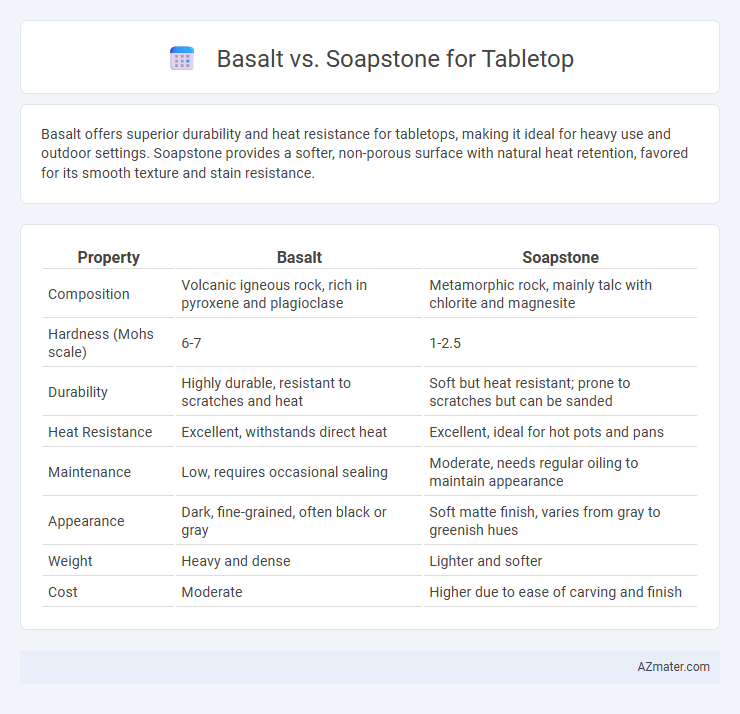Basalt offers superior durability and heat resistance for tabletops, making it ideal for heavy use and outdoor settings. Soapstone provides a softer, non-porous surface with natural heat retention, favored for its smooth texture and stain resistance.
Table of Comparison
| Property | Basalt | Soapstone |
|---|---|---|
| Composition | Volcanic igneous rock, rich in pyroxene and plagioclase | Metamorphic rock, mainly talc with chlorite and magnesite |
| Hardness (Mohs scale) | 6-7 | 1-2.5 |
| Durability | Highly durable, resistant to scratches and heat | Soft but heat resistant; prone to scratches but can be sanded |
| Heat Resistance | Excellent, withstands direct heat | Excellent, ideal for hot pots and pans |
| Maintenance | Low, requires occasional sealing | Moderate, needs regular oiling to maintain appearance |
| Appearance | Dark, fine-grained, often black or gray | Soft matte finish, varies from gray to greenish hues |
| Weight | Heavy and dense | Lighter and softer |
| Cost | Moderate | Higher due to ease of carving and finish |
Introduction to Basalt and Soapstone Tabletops
Basalt tabletops are crafted from dense volcanic rock known for its exceptional durability and heat resistance, making them ideal for high-traffic areas and outdoor use. Soapstone tabletops, composed of a softer metamorphic rock rich in talc, offer a smooth, warm surface with natural resistance to stains and bacteria, preferred for kitchen and indoor settings. Both materials provide unique aesthetic appeal and functional benefits, with basalt favored for its robustness and soapstone valued for its tactile experience and ease of maintenance.
Physical Properties: Basalt vs Soapstone
Basalt exhibits superior hardness and durability with a Mohs hardness rating of around 6, making it highly resistant to scratches and impact, whereas soapstone, rated between 1 and 2.5, is much softer and more prone to surface damage. Soapstone's high talc content grants it excellent heat resistance and exceptional thermal retention, making it ideal for tabletop surfaces exposed to heat. Basalt, an igneous volcanic rock, is denser and less porous than soapstone, offering greater resistance to staining and moisture absorption.
Aesthetic Differences and Color Options
Basalt offers a sleek, dark gray to black appearance with a subtle matte finish, making it ideal for modern and minimalist tabletops. Soapstone features a softer, more varied palette ranging from light gray to green or bluish hues, often with natural veining that adds a warm, organic aesthetic. While basalt provides a uniform and bold look, soapstone's color variations and smooth texture create a timeless, rustic charm suited for diverse interior styles.
Durability and Resistance to Damage
Basalt offers exceptional durability for tabletops due to its high density and hardness, making it highly resistant to scratches, heat, and impact damage. Soapstone, while softer and more susceptible to scratches, excels in resistance to heat and chemical stains, maintaining its appearance over time with proper care. Both materials provide excellent longevity, but basalt's superior strength makes it a preferred choice for heavy-use environments requiring maximum damage resistance.
Maintenance and Cleaning Requirements
Basalt tabletops require minimal maintenance due to their dense, non-porous surface, which resists stains and scratches, making cleaning simple with mild soap and water. Soapstone, being softer and more porous, demands regular oiling to maintain its dark, polished appearance and is more prone to scratches that can be buffed out with fine sandpaper. Both materials benefit from using gentle, non-abrasive cleaners to preserve their natural finish and longevity.
Heat and Stain Resistance Comparison
Basalt offers exceptional heat resistance, withstanding temperatures up to 1,000degC without damage, making it ideal for tabletop surfaces exposed to hot cookware. Soapstone also provides good heat resistance but is more prone to thermal shock, requiring caution with sudden temperature changes. In terms of stain resistance, basalt's dense, non-porous structure resists staining more effectively than soapstone, which, being softer and more porous, can absorb oils and liquids unless regularly sealed.
Environmental Impact and Sustainability
Basalt and soapstone differ significantly in environmental impact and sustainability when used for tabletops. Basalt, a volcanic rock abundant worldwide, requires energy-intensive extraction and processing but offers exceptional durability, reducing the need for frequent replacement. Soapstone is softer and easier to quarry with minimal chemical processing, granting it a lower carbon footprint; however, it may demand more upkeep over time, influencing long-term sustainability considerations.
Cost and Availability of Materials
Basalt tabletops offer moderate affordability with good availability, sourced primarily from volcanic regions, making them a popular choice for budget-conscious consumers. Soapstone is generally more expensive due to its rarity and excavation challenges, but it provides durability and a unique matte finish that justifies the premium. Both materials vary by region, but basalt tends to be more accessible in the global market compared to soapstone, which may require specialized suppliers.
Ideal Applications for Each Stone
Basalt is ideal for tabletops in high-traffic areas due to its durability, heat resistance, and ability to withstand scratches, making it suitable for kitchens and dining rooms. Soapstone, valued for its smooth texture and natural heat retention, is perfect for tabletops in cozy, rustic settings or breakfast nooks where warmth and tactile comfort are desired. Both stones offer unique aesthetic appeals, with basalt's dark, uniform appearance contrasting soapstone's softer, veined patterns, guiding selection based on the intended ambiance and functional needs.
Choosing the Right Stone for Your Tabletop
Basalt offers exceptional durability and resistance to heat and scratches, making it ideal for high-traffic tabletops that require long-lasting performance. Soapstone provides a softer, warmer feel with natural resistance to stains and acids, perfect for kitchens and dining areas seeking a rustic aesthetic. Selecting the right stone depends on balancing basalt's toughness with soapstone's tactile comfort and maintenance needs.

Infographic: Basalt vs Soapstone for Tabletop
 azmater.com
azmater.com